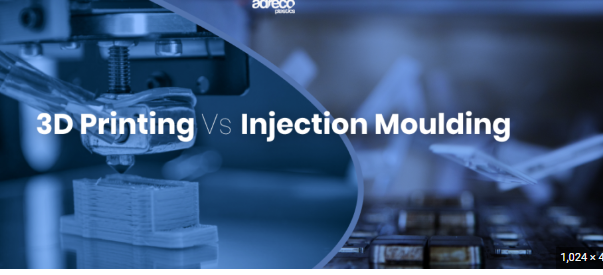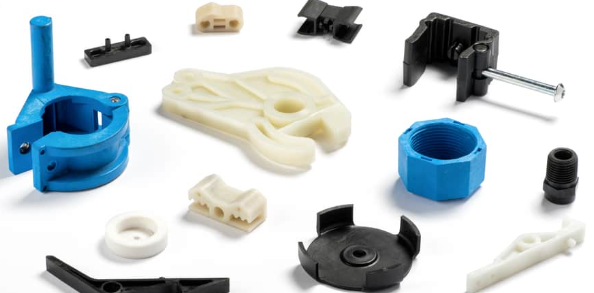3D printed ABS offers design flexibility and lower initial costs, while injection molded ABS excels in mass production efficiency and consistency
3D Printing with ABS
ABS, a thermoplastic polymer, stands out for its toughness and thermal stability. This section delves into the basics of 3D printing technology, the unique characteristics of 3D printed ABS, and its limitations and advantages, enriching the understanding of this material’s application in additive manufacturing.

Basics of 3D Printing Technology
3D printing technology, also known as additive manufacturing, builds objects layer by layer from digital models. It begins with a digital 3D design, usually created in CAD (Computer-Aided Design) software. The printer then extrudes heated ABS filament, layering it precisely according to the design. This technique allows for intricate designs and rapid prototyping, offering a versatile approach to manufacturing.
Characteristics of 3D Printed ABS
3D printed ABS exhibits several key characteristics: it maintains high dimensional stability, shows considerable strength and toughness, and provides a higher degree of flexibility compared to other plastics. It also withstands high temperatures better than PLA (Polylactic Acid), another common 3D printing material. ABS’s smooth finish post-processing makes it ideal for parts requiring an aesthetically pleasing surface.
Limitations and Advantages
Advantages of 3D Printed ABS:
Durability: ABS parts are robust, suitable for functional prototypes and end-use components.
Heat Resistance: It sustains higher temperatures, making it suitable for applications exposed to heat.
Flexibility: ABS can withstand bending and pressure without breaking, ensuring longevity.
Limitations of 3D Printed ABS:
- Emission of Fumes: ABS emits fumes during printing, necessitating ventilation.
- Printer Requirements: It requires a heated print bed and enclosure to prevent warping.
- Post-Processing: ABS often needs additional treatment like sanding or acetone vapor smoothing.
Injection Molding with ABS
Injection molding with ABS (Acrylonitrile Butadiene Styrene) is a widely used process in manufacturing for producing high-volume, high-quality plastic parts. This section explores the fundamental process of injection molding, the distinctive properties of injection molded ABS, and its various advantages and drawbacks. Understanding these elements is crucial for evaluating its suitability for specific applications.
Fundamentals of Injection Molding Process
Injection molding involves melting ABS pellets and injecting the molten plastic into a mold under high pressure. Once the material cools and solidifies, the mold opens to eject the finished part. This process allows for mass production of intricate parts with high precision and repeatability. Key parameters like temperature, pressure, and molding time are meticulously controlled to ensure quality and consistency.
Properties of Injection Molded ABS
Injection molded ABS is renowned for its high impact resistance, rigidity, and excellent surface finish. The process enhances the material’s mechanical properties, making it ideal for products requiring high strength and durability. ABS parts exhibit lower shrinkage rates compared to other thermoplastics, resulting in greater dimensional stability and accuracy.
Advantages and Drawbacks
Advantages of Injection Molded ABS:
- High Production Speed: It enables rapid production of large quantities of parts.
- Precision and Consistency: Produces parts with tight tolerances and uniform quality.
- Complex Part Design: Suitable for complex geometries that might be challenging for other processes.
Drawbacks of Injection Molded ABS:
- High Initial Costs: The cost of mold design and production can be significant.
- Limited Design Changes: Once a mold is made, altering the design can be costly.
- Waste Generation: The process can generate excess plastic, which needs to be managed.
Comparative Analysis: 3D Printing vs. Injection Molding
Comparing 3D printing and injection molding reveals significant differences in terms of quality, precision, cost efficiency, production time, and their suitability for various applications. Each technology has its own set of strengths and weaknesses, making them ideal for different manufacturing scenarios.
Quality and Precision
3D Printing:
- Offers high precision, especially for complex geometries.
- Surface finish may vary and sometimes requires post-processing.
- Ideal for prototypes and small-scale production where detail is key.
Injection Molding:
- Delivers consistently high-quality finishes and precise details.
- Suited for high-volume production with uniform quality.
- Excellent for products requiring high dimensional accuracy and smooth surfaces.
Cost Efficiency and Production Time
3D Printing:
- Low initial setup costs make it cost-efficient for low-volume production.
- Slower production speed compared to injection molding.
- Cost per part remains relatively stable regardless of volume.
Injection Molding:
- Higher initial costs due to mold design and manufacturing.
- Extremely cost-efficient for large-scale production, with a significantly lower cost per part at higher volumes.
- Fast production time after initial setup, ideal for mass production.
Suitability for Different Applications
3D Printing:
- Best suited for customized parts, prototypes, and complex designs that are not mass-produced.
- Allows for design flexibility and easy modifications.
- Useful in industries like aerospace, healthcare, and automotive for specialized parts.
Injection Molding:
- Ideal for high-volume production of parts, especially where uniformity is essential.
- Limited design flexibility post-mold creation.
- Predominantly used in consumer goods, automotive, and medical devices for standardized parts.

Environmental Impact and Sustainability
The environmental impact and sustainability of manufacturing processes like 3D printing and injection molding are critical considerations in today’s eco-conscious world. This section focuses on the waste management practices in both processes and their energy consumption and efficiency, providing a detailed look into how these manufacturing methods fare in terms of environmental responsibility.
Waste Management in Both Processes
3D Printing:
Reduces Material Waste: 3D printing is inherently efficient in material usage, producing minimal waste as it adds material layer by layer to create a part.
Recycling and Reusing Materials: ABS and other plastics used in 3D printing can often be recycled, reducing the environmental footprint.
Challenges in Waste Management: The diversity of materials used in 3D printing complicates recycling processes.
Injection Molding:
Significant Waste from Sprues and Runners: Injection molding generates excess plastic in the form of sprues and runners, which are the channels through which the molten plastic travels.
Recycling of Production Waste: The waste generated can be ground up and recycled, but this may degrade the material quality.
Efforts to Minimize Waste: Advanced injection molding techniques aim to minimize waste production through precise control and optimization of manufacturing processes.
Energy Consumption and Efficiency
3D Printing:
Variable Energy Consumption: Energy usage in 3D printing varies based on the complexity and size of the printed part. Smaller items generally consume less energy.
Efficiency in Low-Volume Production: For small-scale production, 3D printing can be more energy-efficient than traditional manufacturing methods.
Challenges in Scaling Up: As the scale of production increases, the energy efficiency of 3D printing may decrease compared to other manufacturing processes.
Injection Molding:
High Energy Consumption in Initial Setup: The initial phase of heating up the machinery for injection molding consumes significant energy.
Efficiency in Mass Production: Once operational, injection molding is highly efficient for large-scale production, with lower per-part energy consumption.
Continuous Improvements: Technological advancements are continually improving the energy efficiency of injection molding machines.




